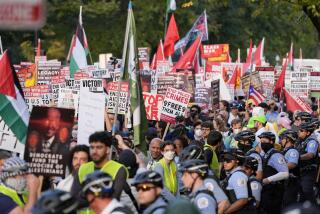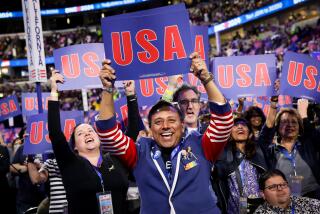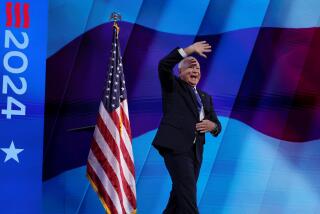Making Chicago Everyone’s Kind of Town
- Share via
CHICAGO — Chi-ca-go, Chi-ca-go, That toddling town,
Chi-ca-go, Chica-go, I’ll show you around . . .
--From “Chicago” by Fred Fisher
*
From the moment they step off their airplanes, Democratic National Convention delegates will see a beautiful city.
A city with flowers in perfect (if forced) bloom, boulevards in perfect (if temporary) repair. A city where cabbies are rarely crabby and police officers--especially police officers--are never mean.
Leave those tear gas-hazed memories of 1968 behind. Forget the grainy black-and-white footage from Hilton Hotel cameras of young people getting their heads bashed in.
It’s a new day and a new Daley. And if Richard II, as local wags address Richard J.’s son, has his way, visitors to his city will go home with a whole new image of “The City That Works.”
It is a carefully cultivated--and just as carefully confined--image designed to refurbish not only the city’s reputation but the Daley family name as well. And as long as the guests don’t stray far beyond a designated 10-block corridor along Michigan Avenue’s “Magnificent Mile,” visitors will see what the city wants them to see.
And that, according to some Chicagoans, is too bad.
“This is a great city, a wonderful city--but it isn’t perfect and there should be no orchestrated pretense to pass it off as perfect,” growls Bobby Rush, the Black Panther-turned-congressman who has his own ideas about what visitors should see in his hometown.
First stop would be the Chicago Police Department.
Rush, like many black activists with a healthy respect for the wooden batons of Chicago’s beat cops, sat out the 1968 protests. But as a leather-jacketed, black-bereted Panther, Rush had plenty of interaction with “Chicago’s Finest” in later years. “I believe I am the only member of Congress to have ever been victimized by illegal search and seizure by a member of the police force of this nation,” Rush boasts today.
Rush wants conventioneers to know that while the Chicago police force is better trained, better educated and more diverse than in the ‘60s, it still does not reflect the “minority majority” population of the city. Today, about a third of the force are ethnic minorities, including the Mexican Polish superintendent Matt Rodriguez. Just one in five officers is female.
And while convention guests are admiring the sparkling lakefront from their downtown hotels, Rush says, they should be aware that the city’s beaches and river aren’t always as clean as they could be.
A likely candidate for mayor himself in 1999, Rush blames the current occupant of that office for allowing the inner city to stagnate and for failing to stimulate new jobs and better community housing programs for Chicago’s neediest citizens, many of them Rush’s constituents.
On the South Side, where Rush lives in the shadow of one of Chicago’s notorious high-rise housing projects, neighbors are steaming over the city’s plan to divert the newest city buses to the Gold Coast hotel-to-convention-center route.
The Chicago Transit Authority plans to pull as many as 100 of its best air-conditioned coaches from regular routes to guarantee cool rides for its credentialed guests. “We believe the convention is something that is positive for the city, [so] any minimal inconvenience for our passengers for a couple of days will be well worth the overall benefit to the city,” CTA executive Lonnie Hill announced without apology last month.
That’s not to say the city is unconcerned about its citizens’ transportation needs--at least during the convention. There will be a larger number of cabs on the streets for it, and they will be operated by drivers who have been threatened with four-hour remedial courtesy classes for each and every outbreak of ill-mannered behavior.
Truth is, Chicago cabbies have always scored well on the surliness scale. And visitors will find them more creative than most in finding the fastest way between two points, even if it involves racing in near darkness along the dank network of highways that twists beneath Michigan Avenue and Wacker Drive beside the suspiciously bright green--could it be algae?--Chicago River.
Another thing missing from the streets next week, according to spokespeople for the city’s politically active homeless men and women, will be them.
Vendors for the city’s Streetwise newspaper--published since 1992 by and for Chicago’s homeless--are telling anyone who’ll listen that, along with broken bottles and cans, the city’s street sweepers are sweeping up their homes.
“They want to make us invisible,” complains John Donahue of the Chicago Coalition for the Homeless. “It’s the same thing they do every time they want to impress outside visitors. They shoo us out of our homes.”
Just as his father did before him, the junior Daley has spruced up shabby areas around the convention site. In 1968, that meant erecting miles of redwood fences between South Side slums and the International Amphitheatre site, east of the stockyards.
This convention, city officials have cleared the rubble from vacant lots along what city planners once called “the belly of the city” along Randolph Street west of the Kennedy Expressway to the vast United Center convention site and its acres of parking lots.
When delegates aren’t convening or partying at Brookfield Zoo or Shedd Aquarium or Comiskey Park, they might ask a cheery cabby to deliver them to the Sears Tower. Although it is no longer the world’s tallest building--a new structure in Kuala Lumpur is higher--it still offers a view of the Second City skyline that is second to none.
And from that lofty perch, Chicago does look beautiful. Perfectly beautiful.
More to Read
Sign up for Essential California
The most important California stories and recommendations in your inbox every morning.
You may occasionally receive promotional content from the Los Angeles Times.










